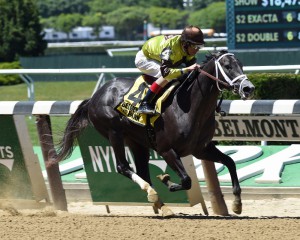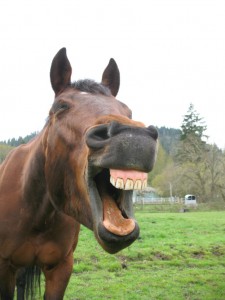Silver Mission romps in Tremont

[1]
NYRA/Adam Coglianese
By Sarah Mace
Twin Creeks Racing Stables and Sequel Racing homebred Silver Mission is leaping nimbly through all the hoops to draw attention to his New York-based first-year sire Mission Impazible[2]. A first starter and first winner for the young stallion, Silver Mission has now become Mission Impazible’s first stakes winner after romping in Belmont’s open $200,000 Tremont Stakes Friday by six-plus lengths.
Jockey John Velazquez and trainer Todd Pletcher opted to send the grey/roan colt, even before the gate scratch of Lady Stardust, who was the odds-on favorite to beat the boys in this 5 1/2-furlong dash.
Said Pletcher, “We were a little concerned with the way the track seemed to be playing. [We] know it’s not a long way to the turns. so you’re not running into the headwind quite as much. These races everybody’s kind of done the same thing. [Every starter has] run once and most of them have won. Most of them are wire-to-wire, so you sort out who’s the quickest.”
Second choice in the Tremont at 2-1 in the field of four that remained, Silver Mission got a jump on the field at the break, comfortably established control and led the field by about a length through a first quarter mile in 22.99 and half in 45.89.
The colt began to draw off more decisively at the head of the stretch and cruised home under a hand ride to win by a margin of 6 1/4 lengths in a final time of 1:03.78. Favorite Hey Mike, Pachi Cruze and Saratoga Two Step filled in the remaining placings. [VIDEO[3]]
Pletcher said after the race, “He caught a great start, Johnny [Velazquez] was super impressed with the way he broke away from there. It was his race to have from there.”
Velazquez commented, “It was pretty easy. He broke well coming out of there. He got to the lead and he kept going. He handled it very well.” The pilot also alluded to the colt’s relatively small size: “He’s pretty quick for a little guy. He’s also pretty talented for as little as he is.”
Silver Mission was a game winner of his debut on April 21, when he defeated four open company juveniles by three-quarters of a length after winning a tough stretch battle and experiencing some contact with the runner-up.
The Tremont winner, who has earned $161,000 from his two victories, is the fourth winner from four starters out of Grade 3 winner and $438,843-earner Nashinda (Silver Deputy) who is a half-sister to Canadian champion Archers Bay (Silver Deputy). Her A.P. Indy filly Nashindy is stakes placed. Nashinda has a yearling full sister to Silver Mission and was bred back to Mission Impazible this year.
Mission Impazible (Unbridled’s Song), a multiple Grade 2 winner campaigned by Twin Creeks Racing and trained by Todd Pletcher, stands at Becky Thomas and Dennis Narlinger’s Sequel Stallions New York[4] for a 2016 stud fee of $7,500. Twin Creeks has vigorously supported the stallion, booking over 20 of their Kentucky-based mares to him in his first season, including Nashinda.
Endnotes:- [Image]: https://www.nytbreeders.org/news/wp-content/uploads/2016/06/silver-mission.jpg
- Mission Impazible: http://www.bloodhorse.com/stallion-register/nytb/stallion/166076/mission-impazible
- VIDEO: http://www.nytbreeders.org/includes/video-player.cfm?date=20160610&track=BED&race=4
- Sequel Stallions New York: http://www.sequelnewyork.com/
Source URL: https://www.nytbreeders.org/news/2016/06/10/silver-mission-tremont/
“Straight from the Horse’s Mouth”: Dr. Ahlschwede on the development of young foals
 [1]By Tom Gallo
[1]By Tom Gallo
This week our guest is Dr. Scott Ahlschwede resident expert on foal development as part of his many responsibilities at the new Rood and Riddle clinic in Saratoga Springs New York.
Dr. Scott Ahlschwede, Partner and Vet for Rood & Riddle Equine Clinic in Saratoga Springs, NY, graduated from Texas A&M College of Veterinary Medicine and began his veterinary career in Lexington, KY as an intern at Rood & Riddle Equine Hospital in 1996. He practiced in the Lexington area for 15 years as an ambulatory veterinarian specializing in reproduction, primary and preventative care, and sales evaluation. In 2012 Dr. Ahlschwede moved to upstate New York to develop Rood & Riddle’s first practice outside of Lexington, KY.
Now that breeding season is coming to an end and most of the foals out of our numerous mares are safely on the ground, standing and nursing I quizzed Dr. Scott about what our priorities and options would and should be moving forward to raise a healthy and correct foal. As we know as breeders we are essentially stuck with what Mother Nature gives us and have to make the best of it. But there are different things we can do to improve things if deemed necessary by a qualified, objective eye. I think objectivity is the key because nobody has an ugly baby. Add to that the fact that you see them every day after a while you may not notice subtle changes. So here we go . . .
Dr. Scott how do we approach the many ways foals growth and development can be augmented and improved with modern day intervention techniques?
Just generally speaking, proper management of foal conformation is part patience and part active intervention at appropriate points in the timeline
When’s the soonest a vet should look at the way a foal stands and walks?
Newborn foals should be assessed early to make sure there aren’t gross abnormalities that can be corrected early. Examples are contracted knees or fetlocks that might need treatment with oxytetracycline or splints. Oxytetracycline relaxes tendons and helps them stretch. It is surprising, for example, a contracted foal that might be knuckling over at the fetlock can be brought back to normal with a couple treatments and a properly applied splint.
There are some foals that are extremely crooked in knees or hocks and they might need a screw and wire very early. Most mild to moderate problems improve with time.
When’s the latest you can do ankle screws?
Foals that turn in should be looked at by vet before 60 days to see if bridging with screws might help. Ankle screws involve place a single screw across the growth plate along one side of the ankle to stop growth while the other side keeps growing to effectively straighten the limb. So for a foal that toes in the screw goes on the outside of the fetlock. The growth plates on fetlocks run out of room for manipulations around 90-120 days. A lot of foals are in at the knee and turn out a little but also have a tendency to toe in from the fetlock. They look okay in the ankle until the knees naturally straighten, then they are pigeon toed. Most foals need some correction on there trims taking more foot off of the inside to effectively “push them out”.
When should a blacksmith start running a rasp around the foal’s hooves?
A blacksmith should be making initial corrective trimming at 2-3 weeks of age. They should be following up with routine trims at least monthly going forward. Maybe a little more frequently if you’re working on a problem.
When’s the latest you can do stripping?
Stripping in another procedure utilized to correct angular deformities. It involves cutting down to the growth plate and lifting the periosteum (bone covering) to increase growth on one side. The maximum effectiveness of this surgery is early in the growth stage.
I use it most commonly for foals moderately in at the knees that are improving on their own but need a little help.
When’s the latest you can do knee screws and wires?
Knees don’t close until after a year of age so there is plenty of time to be patient. Lots of foals are in at the knee mildly but turn the whole leg out from the shoulder down. These are hard to look at and most people want to fix them, but this is an example of ones where it pays to be patient. As the chest expands these horses improve. Surgically there is no fix.
Should foals be eating grain or will it lead to GI issues like ulcers?
It is normal for foals to start eating feed concentrates alongside their mothers. I don’t necessarily believe this is a contributing factor to ulcers. Foal rearing to me is about having a balance and supporting mother nature. There are many ways to raise a horse correctly. Fundamentally, shelter, good nutrition for mare and foal, good grass and turn out, good water and access to salt are the basics. Once those are met, good horsemanship to me is the ability to observe and monitor the growing foal and know when human intervention will be of benefit.
If I get 2 bad foals from a mare from two totally different sire lines should I think about selling her?
That is the question we all wish we had the answer to. There will always stories of mares who were sold then produced their best offspring. From a production standpoint it makes sense to go with the odds and move on. Sometimes the next owner will have better luck.
Thank you Dr. Scott Ahlschwede. Watch for more helpful interviews and if you have any questions for Dr. Ahlschwede or comments, questions, feedback or suggestions for future dialogue, feel free to email them to info@nytbreeders.org[2].
Endnotes:- [Image]: https://www.nytbreeders.org/news/wp-content/uploads/2016/06/LilyYawn.jpg
- info@nytbreeders.org: mailto:info@nytbreeders.org
Source URL: https://www.nytbreeders.org/news/2016/06/10/horses-mouth-ahlschwede/
 [1]
[1] [1]By Tom Gallo
[1]By Tom Gallo